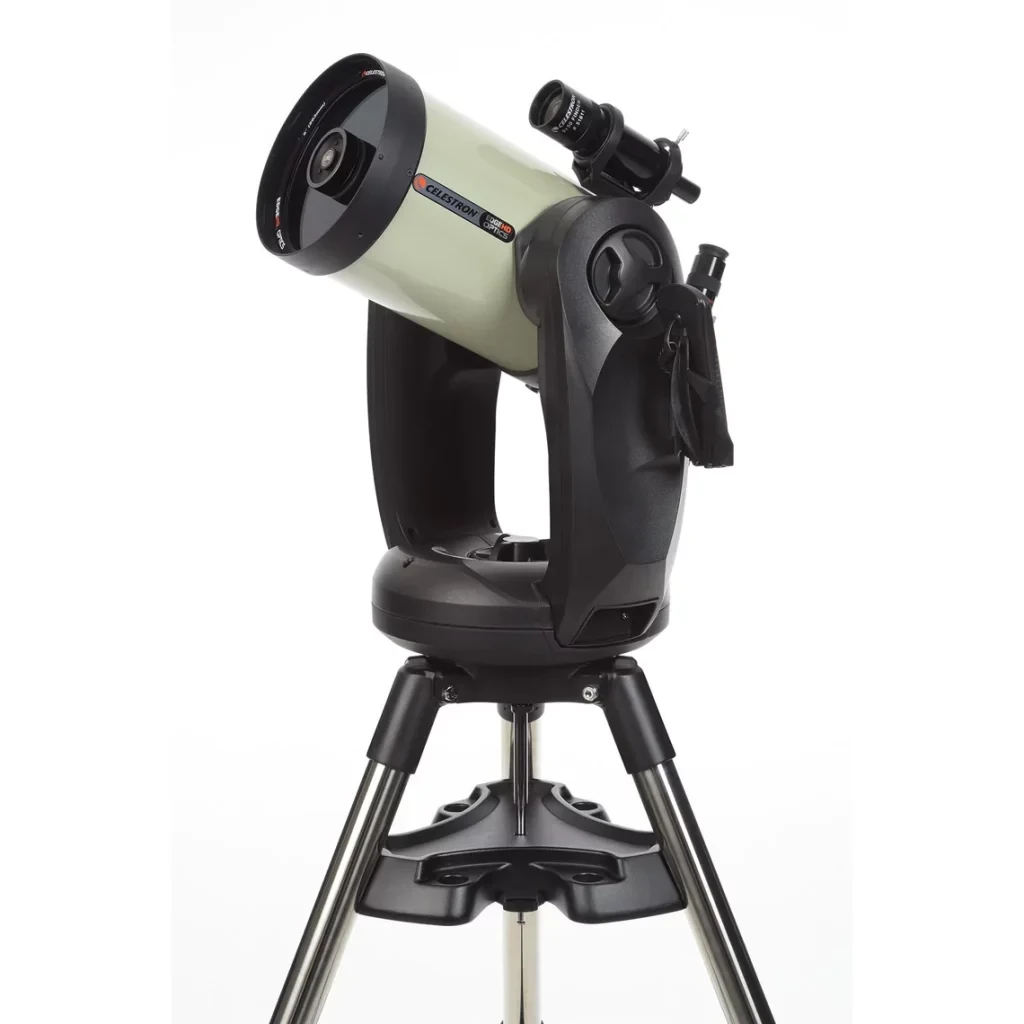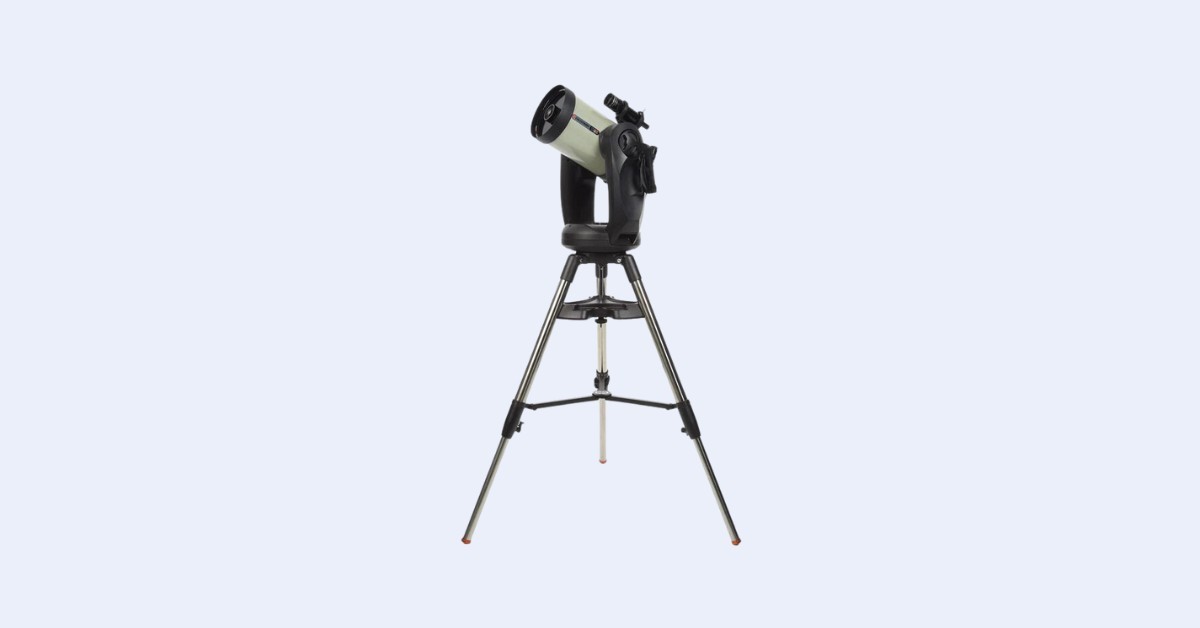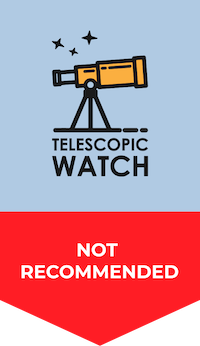The C8 EdgeHD Optical Tube
The Celestron CPC 800 EdgeHD is an aplanatic Schmidt-Cassegrain telescope, with the EdgeHD optical configuration offering superior edge-of-field flattening for astrophotography use when compared to regular Schmidt-Cassegrain telescopes, similar to the Meade ACF telescope design. It features an 8″ (203mm) primary mirror and a 2032mm focal length with a f/10 focal ratio, making it comparable in optical performance to Meade’s “ACF” line of telescopes. The mechanical improvements of the CPC 800 EdgeHD over the regular C8/CPC 800 XLT include mirror locks for astrophotography and HEPA-grade filtered vents for faster cooldown time. It is also compatible with Celestron’s dedicated 8” EdgeHD f/7 focal reducer and Starizona’s HyperStar f/2 conversion kit for astrophotography use.

The CPC 800 EdgeHD functions similarly to other 8” Schmidt-Cassegrain telescopes, and the views it produces are pretty much indistinguishable from those from a CPC 800 GPS. The only improvement you might notice at the eyepiece with the CPC 800 EdgeHD over the regular CPC 800 and other C8 XLT variants is that the slight vignetting at the outer edges of the field of view common for wide-angle 2” eyepieces in regular C8 XLT optical tubes is absent. The field flattening of the EdgeHD design does not really matter for visual use due to the aberrations usually induced by or compensated for with many wide-angle eyepieces. Collimating the telescope is accomplished by adjusting the three Phillips head screws on the secondary mirror holder, which is done while aimed at a bright star; our collimation guide explains the process in further detail.
As with any Schmidt-Cassegrain telescope, the CPC 800 EdgeHD’s focus system moves the primary mirror along a rail inside the telescope, which is adjusted with a knob at the back. The EdgeHD design features mirror locks that can be engaged when you’ve reached focus to avoid “mirror flop” during long exposures for astrophotography, but this is of no benefit for visual use or most planetary imaging work. Standard Schmidt-Cassegrain threads at the back allow you to attach a 2” screw-on diagonal, focal reducers, or adapters such as the 1.25” visual back provided with the scope or a T-adapter for a camera. Holes are drilled into the CPC 800 EdgeHD optical tube to attach dovetail bars for either mounting the telescope to a different mount than the CPC or attaching accessories like a guide scope or power boxes.
Accessories
The CPC 800 EdgeHD comes with a fairly basic set of accessories, including a 9×50 finderscope, a 1.25″ visual back, and a star diagonal, as well as a 1.25” 40mm “E-Lux” Plossl eyepiece that provides 52x magnification when used with the EdgeHD 8”. Its 43-degree apparent field of view, constrained by the 1.25” barrel diameter, means you only get a 0.85-degree true field with the scope, or about 1.5x the apparent diameter of the full Moon. The provided 1.25” accessories are sufficient for basic use, but should you wish to maximize the field of view, a 2” diagonal or f/7 reducer would be needed—something that is not included in the package. Additional eyepieces are also required for higher magnifications.
The CPC’s provided straight-through 9×50 finder slides onto the optical tube on a non-standardized bracket and has crosshairs for more precise pointing; it offers an approximately 6° field of view (albeit with an upside-down view) and allows users to observe stars or even bright deep-sky objects up to several magnitudes fainter than what is visible to the naked eye—which is really overkill for the mere alignment process of a GoTo telescope but certainly still appreciated!
The CPC Fork Mount
The CPC 800 EdgeHD’s mount is a GoTo alt-azimuth fork mount with adjustable clutches for manual aiming when powered off, and an internal clock and GPS system that updates location, date, and time automatically. The EdgeHD 8” optical tube is semi-permanently attached to the mount; however, it can be removed if you plan to bolt on a dovetail or switch over to another mount. Assembling the CPC 800 EdgeHD is relatively simple—just extend and level the tripod, attach the spreader tray, and put the scope on top. The scope’s standard NexStar+ hand controller allows for a simple alignment after centering a few bright stars in the eyepiece, after which it will point to and track any of the 40,000 objects in its database. You can also add other Celestron accessories to the mount, like the StarSense AutoAlign system or the SkyPortal WiFi adapter. The CPC 800 EdgeHD can be converted to an equatorial configuration with an equatorial wedge and has features such as all-metal worm gearing and an autoguider port for deep-sky imaging; however, compared to a good equatorial mount, it is noticeably inferior and not any less expensive for the job.
Should I buy a Used Celestron CPC 800 EdgeHD?
A used CPC 800 EdgeHD may have a failed GPS unit, which is annoying but only a minor inconvenience. The bigger concern is any damage to the EdgeHD optics; unlike a standard Schmidt-Cassegrain, it’s very difficult and certainly a bad idea to repair it yourself, and sending it back to Celestron can cost more than simply buying a unit. Any damage to the corrector plate or internal lenses will also require replacing the entire optical set, which is usually not cost-effective or quick to do. If the telescope powers up, slews, and tracks, and the optics appear to be in good condition, a used unit may be worth the money, especially if it costs less than just buying a new EdgeHD optical tube on its own.
Alternative Recommendations
If you’re looking for a first telescope or really just about any instrument of similar capabilities, there are quite a few better options than the CPC 800 EdgeHD to consider:
Under $1200
- The Apertura AD8/Zhumell Z8/Orion SkyLine 8 offers identical light-gathering and resolving capabilities to the CPC 800 EdgeHD but can achieve a wider true field of view, is simpler to set up, and costs a lot less.
- The Apertura AD10/Zhumell Z10/Orion SkyLine 10 offers greater light-gathering and resolving power compared to an 8” scope like the CPC 800 EdgeHD and includes a wide variety of bonus features and accessories to get you started.
- The Celestron StarSense Explorer 8” offers the same capabilities as any good 8” scope but adds the Celestron StarSense Explorer technology to aid in finding targets as well as a more lightweight and portable base. However, few accessories or other features are included despite its high price.
- The Celestron NexStar 6SE is far more compact than the CPC 800 EdgeHD and only a little small in aperture while offering similar versatile capabilities and an easy-to-use package, though it lacks conveniences like an internal GPS and uses cheaper gearing.
$1200-$2000
- The Apertura AD12/Zhumell Z12/Orion SkyLine 12 offers far more light gathering and resolving power than the CPC 800 EdgeHD but only weighs a little more, though it’s certainly less compact.
- The Sky-Watcher 10” GoTo Collapsible Dobsonian is fairly compact thanks to its FlexTube collapsible tube design and features full motorized tracking and GoTo controlled via your smartphone or tablet, with the ability to aim the scope manually as well.
- The Sky-Watcher 12” Collapsible Dobsonian offers far better views at the eyepiece than the CPC 800 EdgeHD thanks to its greater aperture, while the FlexTube design makes it a little more compact for storage and transport. A GoTo version is also available with FreedomFind encoders allowing for manual aiming as well as operation fully controlled via your smartphone/tablet.
- The Celestron StarSense Explorer 10” Dobsonian offers the same features as the StarSense Explorer 8” Dobsonian and a nearly identical form factor but with greater performance.
- The Celestron NexStar Evolution 6 offers numerous improvements over the NexStar 6SE such as an integrated battery and WiFi, while retaining all of the 6SE’s fabulous features and performance.
$2000+
- The Celestron Advanced VX 9.25” SCT offers more light-gathering and resolving power than the CPC 800 EdgeHD while still remaining easy to set up and transport. The Advanced VX mount is also capable of being used for deep-sky astrophotography with a smaller telescope optical tube.
- The Celestron NexStar Evolution 8 offers the same performance as the CPC 800 EdgeHD but is more portable and features a built-in battery and WiFi.
- The Celestron NexStar Evolution 8 EdgeHD/StarSense has the same EdgeHD optics as the CPC 800 EdgeHD with the bonus of StarSense AutoAlign technology included by default along with the Celestron NexStar Evolution 8’s default features.
Aftermarket Accessory Recommendations
A 2” screw-on star diagonal and a low-power 2” eyepiece such as the Apertura SWA 38mm (53x) will allow you to utilize the full achievable true field of view of the CPC 800 EdgeHD—up to about 1.3 degrees with an eyepiece such as the 38mm SWA—as well as providing a more secure connection with 1.25”/2” hybrid barrel eyepieces. A UHC nebula filter such as the Orion UltraBlock will improve your views of nebulae at the eyepiece, and a 2” version can be used with both 2” eyepieces and with any 1.25” oculars by threading onto a 1.25”-2” adapter such as what is typically provided with most 2” diagonals.
Additional eyepieces for higher magnifications with the CPC 800 EdgeHD would also be a good idea—typically something in the ~20mm range, ~13mm range, and ~8mm range would be a good start. Even “redline” or “goldline” and Plossl eyepieces work well at f/10, but given the cost of this scope, you might want nice eyepieces to go with it; the Baader Hyperion 21mm (97x) or 13mm (156x), or Explore Scientific 82-degree 18mm (113x) or 14mm (145x), and for the highest power, an Explore Scientific 8.5mm 82-degree (239x) or 6.5mm 82-degree (313x) would be our top picks. However, these are just suggestions, and a wide variety of eyepieces are able to fit your needs and may be better based on your own personal preferences. A Barlow lens can be used for imaging purposes as well as supplementing or replacing short focal length eyepieces, too.
A power supply of some sort is also needed to run the CPC 800 EdgeHD, such as the Celestron PowerTank Lithium Pro or a generic equivalent, and you’ll want a dew shield to protect the telescope’s front corrector plate from dew as well as dust/dirt; the dew shield also acts like a lens hood and prevents some of the worst glare sources from getting inside the telescope and wrecking the view.
What can you see?
With a 2″ wide-angle eyepiece or by using a 0.7x reducer with the included 40mm Plossl, the CPC 800 EdgeHD offers a maximum field of view of 1.3 degrees, much narrower than that provided by other telescopes like Dobsonians of similar aperture but still wide enough for the bulk of large deep-sky objects. Double stars are, of course, plentiful regardless of your observing conditions, and the sharp optics of the CPC 800 EdgeHD have no trouble splitting many of them. The largest open star clusters and nebulae simply won’t fit in the scope’s limited field of view, but those that do are breathtakingly beautiful. The Double Cluster in Cassiopeia, the Wild Ducks (M11) in Scutum, the Pleiades (M45) in Taurus, and other open clusters like M35 are a delight. Brighter globular clusters such as M13 or M15 can be resolved into individual stars at high magnifications, even under somewhat light-polluted skies. Nebulae like Orion (M42) and the Lagoon (M8) are easy to see even from the suburbs, but they are best with dark skies and a UHC nebula filter.
When observing galaxies through any telescope, the amount of detail you can see will depend on where you’re viewing from. If light pollution is an issue, you may only be able to pick out washed-out smudges against a bright white background. However, in a dark location with good viewing conditions and the CPC 800 EdgeHD, you’ll be able to spot hints of spiral arms and high-contrast dust lanes in many galaxies, such as M31, M64, M65, and M82. Not only that, but groups of dozens or even hundreds of galaxies, such as the Virgo Cluster or Fornax galaxy cluster, will also become visible.
Solar System objects are also a delight with the CPC 800 EdgeHD. Mercury and Venus show phases depending on their positions relative to Earth; Mars reveals its polar ice caps along with a few dark markings on its surface when it is closest to Earth and conditions are good. The Moon is splendid at any magnification under any viewing conditions with the CPC 800 EdgeHD, showing jaw-dropping detail in craters, mountains, and tiny ridges and cracks when atmospheric stability permits. Jupiter’s cloud belts and Great Red Spot offer a stunning view along with four Galilean moons; the moons are easily resolved as tiny disks with jet-black shadows whenever they transit in front of the gas giant. Saturn appears with the Cassini Division easily resolved (along with maybe even the Encke gap if you’re lucky) in its rings, plus several moons and some dull cloud banding in the planet’s atmosphere. Uranus’ tiny teal disk is resolved, and its moons are at the threshold of visibility with the CPC 800 EdgeHD; Neptune is a tiny blue dot barely bigger than a star-like point, and its moon Triton is easy to see next to it, while Pluto is invisible without a larger instrument owing to its dimness and continual decrease in brightness as it retreats from the Sun’s glow for the foreseeable future.
Astrophotography Capabilities
While usable for deep-sky imaging with a wedge and either a Hyperstar f/2 kit or f/7 reducer, the CPC 800 EdgeHD is extremely difficult to accurately polar align in such a configuration, and its overall tracking/guiding quality are inferior to the capabilities of a quality German equatorial mount such as the Sky-Watcher EQ6Ri Pro or Celestron CGX, which would be typically paired with the EdgeHD 8” optical tube.
Lunar and planetary imaging is easy to do with any good Schmidt-Cassegrain telescope on a GoTo mount, and the CPC 800 EdgeHD is no exception (though the EdgeHD optics provide little advantage over the standard C8 XLT/CPC 800 for the task). Simply get a good planetary camera like the ZWO ASI224MC, plug it into a laptop with capture software, and add a 2x or 3x Barlow lens to boost the scope to f/20-f/30, and you can get gorgeous results in just a few minutes.



